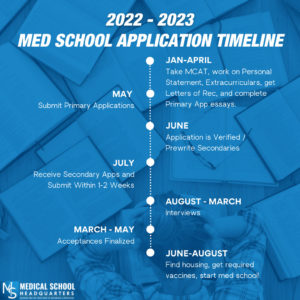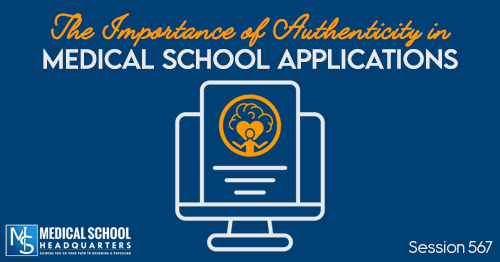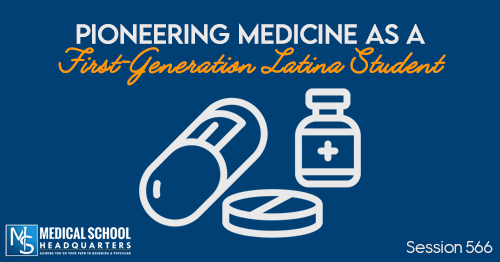Students who want to start medical school in the Summer/Fall of 2024 will need to submit their applications in the Summer of 2023, a year in advance. It’s a good idea to begin preparing for this and drafting aspects of your application in the Winter of the year you apply. We recommend starting to work on your personal statement in January before you apply. A few months out from applying, you should have the majority of your extracurriculars under your belt, and continue in some of them during the process of applying. You should also have enough clinical experience to explain why you want to be a physician confidently.
There are many steps to putting together a successful medical school application, so here we’ll break it down a few months at a time so you can refer back to this and make sure you’re on track. If you want additional help in a supportive community, enroll in Application Academy, which now gives you access to a year of application prep from the time you sign up. Another great way to learn more about each step in this long process is to read the Premed Playbook Guide to the Medical School Application Process*.
Getting the timing right is crucial because many admissions committees review applications as they come in and fill their interview slots accordingly. If you’re at the bottom of the stack, the school might be out of interview dates before they get to you.

January – April
Work on Your Personal Statement
Check out the Premed Playbook Guide to the Medical School Personal Statement if you don’t know where to start. It will teach what a personal statement is and isn’t and show you examples from students who were accepted to medical school and feedback on their essays. You can also check out The Premed Years Session 423: How to Tell Your Story in a Compelling Way to Med Schools.
Prep for the MCAT
Prep now to take the MCAT ideally in March or April, but a May or June date will still fit into the ideal timeline as long as the rest of your application is also ready to go. It can be hard to balance prepping for the MCAT and writing your application, so spend some time thinking about how to balance the two early. Early in the process can be an excellent time to write a super rough draft of your personal statement to get your ideas on paper, and then you can work on finalizing it as you wait for your MCAT score to come back. Learn what to avoid when planning your MCAT study schedule here.
Plan for Letters of Recommendation
If you plan to get a committee letter through your undergraduate institution, find out what the process is and whether you qualify, and don’t panic if you don’t qualify. If there are any schools, you’re sure you want to apply to, find out what their LOR requirements are and think of who might be able to meet those for you. Begin reaching out, and make sure you give your writers enough time. If you receive letters before they’re due, Interfolio can be a great way to store them. Being able to work with your recommenders’ schedules can be very helpful in ensuring they have the availability to write you a great letter.
Check out Inside Med Admissions 2: Letters of Recommendation for more on this.
May – June
Write and Submit Your Primary Application
All three application services–AMCAS for MD schools, AACOMAS for DO schools, and TMDSAS for Texas schools–open in early May. When you can hit submit varies between the services. Spend time in May carefully entering all of your coursework, activity hours, and everything else that goes into your primary application. You can draft all of the essay portions in your Mappd account and have them ready to go. Take care to enter everything exactly as it’s listed on your transcript because any errors will lengthen the verification process. Very few aspects of the primary application can be edited after submission, and this also varies, so read each services’ instruction manual for more information. These and the application services’ websites are the best places to find the most up-to-date policies.
When you can submit your application depends on the service. AACOMAS permits the earliest submission – as soon as you’ve finished filling it out. Even though submitting early in the cycle is essential, don’t rush and submit something unfinished. Fill everything out, and then look over it one last time on a separate day to ensure it’s ready before sending it. Do this for each application you submit. AMCAS can typically be submitted at the end of May or in the first few days of June. TMDSAS has recently shifted to allowing submissions in mid-May once Texas students have access to their spring grades.
Application Verification
After you submit, the staff at each organization comb through your application, making sure everything falls within policy and matches the other material they have about you, like your official transcript from your university. This can take anywhere from days to six weeks at the extremes. Historically, AMCAS has taken the longest time to verify applications. This tends to take longer later in the cycle as more applicants are waiting in line. This will also take much longer if you have any errors and the reviewer has to track you down to correct something.
Applications Get Pushed to Medical Schools
AMCAS holds the earliest applications back and transmits them to schools in a batch in late June. AACOMAS does the same and sends them over in mid-June. TMDSAS does not do this, and schools receive applications as students submit them before they’re necessarily verified. This process isn’t essential for you to understand in detail. Still, it’s helpful to have a rough idea so you know not to panic if you submitted your primary application as early as possible and haven’t yet received any secondaries in June.
Prewrite Secondaries
Even if you haven’t started receiving your secondary prompts yet, it’s helpful to begin writing them ahead of time. This will allow you to submit them quickly as they come in and not be overwhelmed with trying to write them all at once. This also gives you time to write more than one draft. You won’t and shouldn’t spend as much time on these as you did on your personal statement, but you still want to put effort and care into them. You can see schools’ previous prompts here and use those as a reference for prewriting.
July
Edit and Return Secondary Applications
Polish secondaries and submit them ideally within two weeks of receiving them. If you need a couple of extra days to polish them, do that, but don’t take weeks and weeks extra. If you are late, still submit them, but you may be asked if there’s a reason for the delay in an interview.
August – March
Interview Season
Even if you don’t receive an interview invite early in this process, don’t lose hope and continue to prepare as if you might receive one or multiple interview invitations. Know what types of interviews you might have to do, based on the schools you applied to. The most common types are the MMI, one-on-one interviews, and interview panels. You can read more about the types of interviews and how to prepare for them in The Premed Playbook Guide to the Medical School Interview. You can also use our free mock interview platform or sign up for a mock interview session with one of our Mappd advisors.
Admissions Decisions
These timelines vary based on when you interviewed and what applications you submitted. AMCAS has a rule that admissions committees can’t offer acceptances until mid-October (except for Early Decision applicants). AACOMAS doesn’t restrict when acceptances can be sent out, but the interview-to-decision timing still varies between schools. TMDSAS has a separate Match process for Texas residents, and the best ways to keep up with how the TMDSAS Match works are to read about it in The Premed Playbook Guide to the Medical School Application Process and on the TMDSAS website.
Possible admissions decisions include rejection, waitlisting, and the coveted acceptance that we hope you all receive. This process can last until orientation and classes begin. You can learn more about the waitlist process in our Guide to the Medical School Waitlist.
Good luck with your applications, and keep an eye out on posts diving deeper into each step of the application process!
*affiliate link, we receive a small commission if you purchase through this link.







